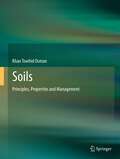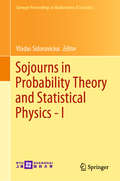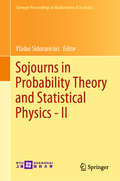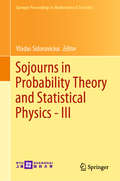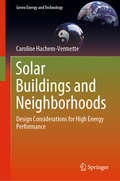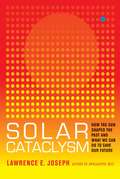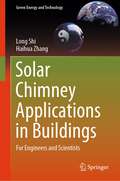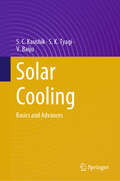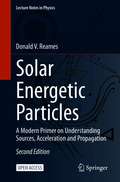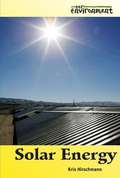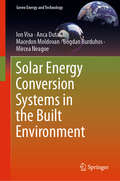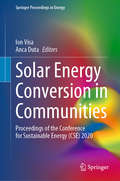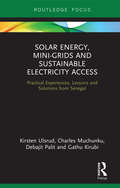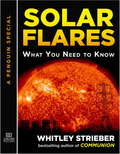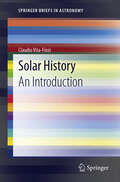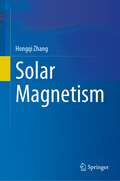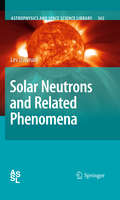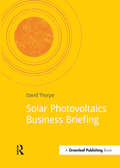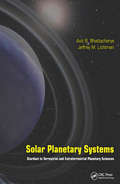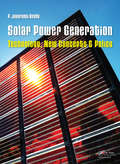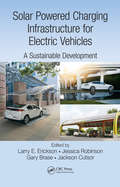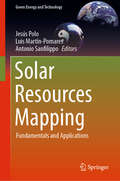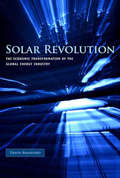- Table View
- List View
Soils: Principles, Properties and Management
by Khan Towhid OsmanAimed at taking the mystery out of soil science, Soils: Principles, Properties and Management is a text for undergraduate/graduate students who study soil as a natural resource. Written in a reader-friendly style, with a host of examples, figures and tables, the book leads the reader from the basics of soil science through to complex situations, covering such topics as: the origin, development and classification of soil physical, chemical and biological properties of soil water and nutrient management management of problem soils, wetland soils and forest soils soil degradation Further, the ecological and agrological functions of soil are emphasized in the context of food security, biodiversity and climate change. The interactions between the environment and soil management are highlighted. Soil is viewed as an ecosystem itself and as a part of larger terrestrial ecosystems.
Sojourns in Probability Theory and Statistical Physics - I: Spin Glasses and Statistical Mechanics, A Festschrift for Charles M. Newman (Springer Proceedings in Mathematics & Statistics #298)
by Vladas SidoraviciusCharles M. (Chuck) Newman has been a leader in Probability Theory and Statistical Physics for nearly half a century. This three-volume set is a celebration of the far-reaching scientific impact of his work. It consists of articles by Chuck’s collaborators and colleagues across a number of the fields to which he has made contributions of fundamental significance. This publication was conceived during a conference in 2016 at NYU Shanghai that coincided with Chuck's 70th birthday.The sub-titles of the three volumes are: I. Spin Glasses and Statistical MechanicsII. Brownian Web and PercolationIII. Interacting Particle Systems and Random Walks The articles in these volumes, which cover a wide spectrum of topics, will be especially useful for graduate students and researchers who seek initiation and inspiration in Probability Theory and Statistical Physics.
Sojourns in Probability Theory and Statistical Physics - II: Brownian Web and Percolation, A Festschrift for Charles M. Newman (Springer Proceedings in Mathematics & Statistics #299)
by Vladas SidoraviciusCharles M. (Chuck) Newman has been a leader in Probability Theory and Statistical Physics for nearly half a century. This three-volume set is a celebration of the far-reaching scientific impact of his work. It consists of articles by Chuck’s collaborators and colleagues across a number of the fields to which he has made contributions of fundamental significance. This publication was conceived during a conference in 2016 at NYU Shanghai that coincided with Chuck's 70th birthday.The sub-titles of the three volumes are:I. Spin Glasses and Statistical MechanicsII. Brownian Web and PercolationIII. Interacting Particle Systems and Random WalksThe articles in these volumes, which cover a wide spectrum of topics, will be especially useful for graduate students and researchers who seek initiation and inspiration in Probability Theory and Statistical Physics.
Sojourns in Probability Theory and Statistical Physics - III: Interacting Particle Systems and Random Walks, A Festschrift for Charles M. Newman (Springer Proceedings in Mathematics & Statistics #300)
by Vladas SidoraviciusCharles M. (Chuck) Newman has been a leader in Probability Theory and Statistical Physics for nearly half a century. This three-volume set is a celebration of the far-reaching scientific impact of his work. It consists of articles by Chuck’s collaborators and colleagues across a number of the fields to which he has made contributions of fundamental significance. This publication was conceived during a conference in 2016 at NYU Shanghai that coincided with Chuck's 70th birthday.The sub-titles of the three volumes are:I. Spin Glasses and Statistical MechanicsII. Brownian Web and PercolationIII. Interacting Particle Systems and Random WalksThe articles in these volumes, which cover a wide spectrum of topics, will be especially useful for graduate students and researchers who seek initiation and inspiration in Probability Theory and Statistical Physics.
Solar Adobe: Energy, Ecology, and Earthen Architecture
by Albert NarathHow a centuries-old architectural tradition reemerged as a potential solution to the political and environmental crises of the 1970s Against the backdrop of a global energy crisis, a widespread movement embracing the use of raw earth materials for building construction emerged in the 1970s. Solar Adobe examines this new wave of architectural experimentation taking place in the United States, detailing how an ancient tradition became a point of convergence for issues of environmentalism, architecture, technology, and Indigenous resistance. Utilized for centuries by the Pueblo people of the American Southwest and by Spanish colonialists, adobe construction found renewed interest as various groups contended with the troubled legacies of modern architecture and an increasingly urgent need for sustainable design practices. In this period of critical experimentation, design networks that included architects, historians, counterculture communities, government weapons labs, and Indigenous activists all looked to adobe as a means to address pressing environmental and political issues. Albert Narath charts the unique capacities of adobe construction across a wide range of contexts, consistently troubling simple distinctions between traditional and modern technologies, high design and vernacular architecture. Drawing insightful parallels between architecture, environmentalism, and movements for Indigenous sovereignty, Solar Adobe stresses the importance of considering the history of the built environment in conjunction with architecture&’s larger impact on the natural world.
Solar Buildings and Neighborhoods: Design Considerations for High Energy Performance (Green Energy and Technology)
by Caroline Hachem-VermetteThis book presents the main principles for designing buildings and neighborhoods with increased potential to capture and utilize solar energy. It discusses practical issues in the design of the built environment and their impact on energy performance; and a range of design considerations, from building components (e.g. the building envelope) to urban planning issues (e.g. density and street layouts). In addition to design guidelines on how to increase buildings’ potential to capture solar energy, the book provides creative tips to increase the aesthetic value of solar technology integration in buildings. Helping readers plan energy-efficient buildings with innovative building envelope technologies, and to understand the impact of early-stage design considerations on the energy performance of buildings and communities, the book offers a valuable source of information for building professionals, including architects, engineers, and urban planners. It can also serve as a reference guide for academics and students of energy efficiency in buildings and urban planning.
Solar Cataclysm: How the Sun Shaped the Past and What We Can Do to Save Our Future
by Lawrence E. JosephScience journalist and futurist Lawrence Joseph has studied the unprecedented solar storms since the last ice age and in Solar Cataclysm he reveals the monumental ecological, biological, emotional, political, financial, and cultural effects they have had in the past, and will ultimately have on humanity’s future. This timely, fascinating, and relevant book from the bestselling author of Apocalypse 2012 sounds an intelligent and urgent warning about the possible catastrophic consequences we will face in the coming years if we don’t listen to what the sun is trying to tell us. Popular science fans who made The World Without Us a runaway bestseller, readers open to new angles on history like those presented in Guns, Germs, and Steel, and anyone who is concerned about tomorrow and what we can do to ensure humankind’s survival must read Solar Cataclysm.
Solar Chimney Applications in Buildings: For Engineers and Scientists (Green Energy and Technology)
by Long Shi Haihua ZhangThis book comprehensively describes the operating principles and theoretical foundations of solar chimneys. It covers current research results, including numerical analysis and mathematical models based on different assumptions. Complying with the application of renewable energy in sustainable buildings, solar chimney has received extensive attention as an indispensable part natural ventilation. This book is a guide to the application of solar chimneys from single zones to multi zones, and it provides a reference source of application for construction practitioners and engineering decision-makers. The design basis and the related basic principles of fluid mechanics and natural ventilation design strategies introduced in this book will also be beneficial to college students.
Solar Cooling: Basics and Advances
by S. C. Kaushik S. K. Tyagi V. BaijuThe book deals with the research activities focussed on solar VAD systems evaluating its merit of compatibility with ozone friendly refrigerants and adoptability with solar energy option. The authors of this book have given more emphasis on discussing various solar cooling VAD systems and its viability for the commercial use. Relevant references on "Solar Cooling: Basics and Advances" has been provided which significantly adopt some of the information for the completeness of the book.
Solar Energetic Particles: A Modern Primer on Understanding Sources, Acceleration and Propagation (Lecture Notes in Physics #978)
by Donald V. ReamesThis open access book serves as a concise primer introducing the non-specialist reader to the physics of solar energetic particles (SEP). It systematically reviews the evidence for the two main mechanisms which lead to the so-called impulsive and gradual SEP events. This second edition contains two completely new chapters discussing element abundances and shock waves, reflecting new theoretical, modeling, and observational results. Existing chapters have been substantially expanded or updated with additions placed in a broader context.More specifically, the author discusses the timing of the onsets of SEPs, their longitude distributions, their high-energy spectral shapes, their correlations with other solar phenomena, as well as the all-important elemental and isotopic abundances. The book relates impulsive SEP events to magnetic reconnection in solar flares and jets. The concept of shock acceleration by scattering on self-amplified Alfvén waves is introduced, as is the evidence of reacceleration of impulsive-SEP material in the seed population accessed by the shocks in gradual events. The text then develops processes of transport of ions out to an observer. Finally, a technique to determine the source plasma temperature in both impulsive and gradual events is demonstrated.The author also mentions the role of SEP events as a radiation hazard in space and briefly discusses the nature of the main particle telescope designs that have contributed to most of the SEP measurements.
Solar Energy (Our Environment)
by Kris HirschmannHumankind's dependence on fossil fuels is depleting the Earth's resources. Solar energy is one possible solution to this problem. This book examines all aspects of the solar energy question-how solar energy works, its problems and potential, where it is being used today and more.
Solar Energy Conversion Systems in the Built Environment (Green Energy and Technology)
by Ion Visa Anca Duta Macedon Moldovan Bogdan Burduhos Mircea NeagoeThis book focuses on solar energy conversion systems that can be implemented in the built environment, at building or at community level. The quest for developing a sustainable built environment asks for specific solutions to provide clean energy based on renewable sources, and solar energy is considered one of the cleanest available energy on Earth. The specific issues raised by the implementation location are discussed, including the climatic profile distorted by the buildings, the available surface on the buildings for implementation, etc. This book also discusses the seasonal and diurnal variability of the solar energy resource in parallel with the variability of the electrical and thermal energy demand in the built environment (particularly focusing on the residential buildings). Solutions are proposed to match these variabilities, including the development of energy mixes with other renewables (e.g. geothermal or biomass, for thermal energy production). Specific solutions, including case studies of systems implemented on buildings all over the world, are presented and analyzed for electrical and for thermal energy production and the main differences in the systems design are outlined. The conversion efficiency (thus the output) and the main causes of energy losses are considered in both cases. The architectural constraints are additionally considered and novel solar energy convertors with different shapes and colors are presented and discussed. The durability of the solar energy conversion systems is analyzed considering the specific issues that occur when these systems are implemented in the built environment; based on practical examples, general conclusions are formulated and specific aspects are discussed in relation to experimental results and literature data. With renewables implemented in the built environment likely to expand in the near future, this book represents welcome and timely material for all professionals and researchers that are aiming to provide efficient and feasible solutions for the sustainable built environment.
Solar Energy Conversion in Communities: Proceedings of the Conference for Sustainable Energy (CSE) 2020 (Springer Proceedings in Energy)
by Ion Visa Anca DutaThis book presents novel findings concerning the systems, materials and processes used in solar energy conversion in communities. It begins with the core resource – solar radiation – and discusses the restrictions on the wide-scale implementation of conversion systems imposed by the built environment, as well as potential solutions. The book also describes efficient solar energy conversion in detail, focusing on heat and electricity production in communities and water reuse. Lastly, it analyzes the concept of sustainable communities, presenting examples from around the globe, along with novel approaches to improving their feasibility and affordability. Though chiefly intended for professionals working in the field of sustainability at the community level, the book will also be of interest to researchers, academics and doctoral students.
Solar Energy, Mini-grids and Sustainable Electricity Access: Practical Experiences, Lessons and Solutions from Senegal (Routledge Focus on Environment and Sustainability)
by Debajit Palit Kirsten Ulsrud Charles Muchunku Gathu KirubiThis book presents new research on solar mini-grids and the ways they can be designed and implemented to provide equitable and affordable electricity access, while ensuring economic sustainability and replication. Drawing on a detailed analysis of solar mini-grid projects in Senegal, the book provides invaluable insights into energy provision and accessibility which are highly relevant to Sub-Saharan Africa, and the Global South more generally. Importantly, the book situates mini-grids in rural villages within the context of the broader dynamics of national- and international-level factors, including emerging system innovation and socio-technical transitions to green technologies. The book illustrates typical challenges and potential solutions for practitioners, policymakers, donors, investors and international agencies. It demonstrates the decisive roles of suitable policies and regulations for private-sector-led mini-grids and explains why these policies and regulations must be different from those that are designed as part of an established, centralized electricity regime. Written by both academics and technology practitioners, this book will be of great interest to those researching and working on energy policy, energy provision and access, solar power and renewable energy, and sustainable development more generally.
Solar Flares: What You Need to Know
by Whitley StrieberThere is a force out there that could destroy our world in minutes. . . .Solar flares--brief bursts of radiation from our sun--have always existed and have never been particularly dangerous. Nature hasn't changed. But we have. <P><P>By making our world so dependent on electricity delivered by huge, unprotected power grids we have inadvertently placed humanity at terrible risk. As bestselling author Whitley Strieber explores in this urgent new work, a powerful solar flare could demolish our electrical delivery system, wiping away centuries of civilization in minutes and drastically changing our world.Such a scenario is altogether plausible--and it is the single most dangerous single thing that could happen to our civilization, more dangerous than the most massive earthquake or volcano, more dangerous than climate change, more dangerous even than nuclear war. What is worse, solar flares of a now-dangerous intensity are not all that uncommon; and not only that, our electrical and electronic infrastructure is becoming so extensive, and thus so fragile, that smaller and smaller solar flares can pose more and more serious hazards.<P>Due to the astonishing unwillingness of power companies to cooperate, good programs that would make us safer, and that are supported by both political parties, have been routinely prevented from being enacted.In Solar Flares: What You Need to Know, Strieber reveals the dangers behind solar flares, tracks the disastrous damage they could cause, surveys what they would do to our world in the here-and-now, and explains what nations and individuals must do to prepare for them.
Solar History
by Claudio Vita-FinziBeyond the four centuries of sunspot observation and the five decades during which artificial satellites have monitored the Sun - that is to say for 99.99999% of the Sun's existence - our knowledge of solar history depends largely on analogy with kindred main sequence stars, on the outcome of various kinds of modelling, and on indirect measures of solar activity. They include the analysis of lunar rocks and meteorites for evidence of solar flares and other components of the solar cosmic-ray (SCR) flux, and the measurement of cosmogenic isotopes in wood, stratified ice and marine sediments to evaluate changes in the galactic cosmic-ray (GCR) flux and thus infer changes in the sheltering magnetic fields of the solar wind. In addition, shifts in the global atmospheric circulation which appear to result from cyclic fluctuations in solar irradiance have left their mark in river sediments and in the isotopic composition of cave deposits. In this volume the results these sources have already produced have been summarised, paying special attention to those that reflect processes in different parts of the Sun's interior and that display periodicities and trends which may enable us to forecast future large-scale environmental changes.
Solar Home Design Manual for Cool Climates
by Shawna Henderson Don RoscoeIf you want an inexpensive, environmentally sound source of energy for your home, you need look no further than the sun. Solar heat is not subject to rate increases, is totally renewable, pollution free and requires little or no technology. It is here for you today, and can easily provide up to 50% of your space and water heating requirements. This is a book that simply and clearly explains the principles of using solar energy to heat your home. Anyone building a new home, or renovating an old one can incorporate one or several aspects of solar energy into their design. Taking you through the process of designing a solar home from the ground up this manual is also a basic course in conservation and sustainable house design. If you live in a 'heating' climate, meaning if you have space heating requirements for most of the year then this is an invaluable resource. A house is the biggest single investment most of us will make in our lives - the way it is built and how it operates can reflect a long term investment in both the building and the planet.
Solar Magnetism
by Hongqi ZhangThis book highlights fundamentals and advances in the theories and observations of solar magnetic fields. Solar magnetism is an important part of solar physics and space weather research. It covers the formation, development, and relaxation of the magnetic fields in the solar eruptive process. The book discusses topics ranging from measurement facilities for solar observations to the evolution of solar magnetic fields, the storage of magnetic energy, and the magnetic helicity in the solar atmosphere and its relation with solar cycles. The book also presents recent advances in measurements and observations of solar magnetic shear, currents, magnetic helicity, and solar cycles. The book intends for astronomy-majored students and researchers interested in solar magnetism and its role in astrophysics.
Solar Neutrons and Related Phenomena
by Lev DormanThis book presents the first comprehensive compilation and review of the extensive body of experimental and theoretical material on solar neutrons and related phenomena published in the scientific literature over the last sixty years. Phenomena related to solar neutrons are more specifically: - the decay products of solar neutrons - solar gamma rays generated in processes like nuclear reactions between solar energetic charged particles and matter of the solar atmosphere, as well as by the capture of solar neutrons by hydrogen atoms in the solar atmosphere - the propagation of solar neutrons, solar gamma rays and other secondary particles through the solar photosphere, chromosphere and corona, as well as through interplanetary space and through the Earth's atmosphere. Models and simulations of particle acceleration, interactions, and propagation processes show that observations of solar neutrons and gamma rays in space and in the Earth's atmosphere yield essential and unique information on the source function of energetic solar particles, as well as on the chemical composition and density distribution of plasma in the solar atmosphere. The results described in the book may also be useful for astrophysical studies of other stars and different astrophysical objects, as well as for space weather problems. The book will serve as a reference work for researchers and students in solar physics, plasma, neutron, and gamma ray physics, as well as in cosmic ray physics, space science, geophysics and those researching space weather problems.
Solar Photovoltaics Business Briefing (Doshorts Ser.)
by David ThorpeThis book explains, for a UK business audience, the technical, scientific and economic aspects of solar photovoltaics (PV) technologies. It is useful to anyone considering a business use of solar PV, whether an investor, potential purchaser, or thinking of setting up a company in the sector.It succinctly examines: their applications and how to assess them; the prospects and drivers for cost reductions and implementation; the role of PV in carbon offsetting; and the business case for and against investment.It will arm the reader with sufficient knowledge to talk to contractors or to compile a business investment case for senior management.PV is the sunrise sector for electricity generation; the renewable technology whose time has come. Clean, and with no moving parts to wear out, it interfaces neatly with other technologies, both digital and analogue. Cost curves are decreasing and installation curves exponentially rising. Although silicon-based cells are well-known, due to the feed-in tariff support they receive, within the next five to eight years, lowering production costs and technological innovations will mean that solar electricity will be poised to find even more widespread applications.
Solar Planetary Systems: Stardust to Terrestrial and Extraterrestrial Planetary Sciences
by Asit B. Bhattacharya Jeffrey M. LichtmanThe authors have put forth great efforts in gathering present day knowledge about different objects within our solar system and universe. This book features the most current information on the subject with information acquired from noted scientists in this area. The main objective is to convey the importance of the subject and provide detailed information on the physical makeup of our planetary system and technologies used for research. Information on educational projects has also been included in the Radio Astronomy chapters.This information is a real plus for students and educators considering a career in Planetary Science or for increasing their knowledge about our planetary system.
Solar Power Generation: Technology, New Concepts & Policy
by P. Jayarama ReddyThis book offers a global perspective of the current state of affairs in the field of solar power engineering. In four parts, this well-researched volume informs about:Established solar PV (photovoltaic) technologiesThird-generation PV technologies based on new materials with potential for low-cost large-scale productionSolar cell technology based
Solar Powered Charging Infrastructure for Electric Vehicles: A Sustainable Development
by David Morley, Xiaoming Li, Crispin JenkinsonThe Paris Agreement on Climate Change adopted on December 12, 2015 is a voluntary effort to reduce greenhouse gas emissions. In order to reach the goals of this agreement, there is a need to generate electricity without greenhouse gas emissions and to electrify transportation. An infrastructure of SPCSs can help accomplish both of these transitions. Globally, expenditures associated with the generation, transmission, and use of electricity are more than one trillion dollars per year. Annual transportation expenditures are also more than one trillion dollars per year. Almost everyone will be impacted by these changes in transportation, solar power generation, and smart grid developments. The benefits of reducing greenhouse gas emissions will differ with location, but all will be impacted. This book is about the benefits associated with adding solar panels to parking lots to generate electricity, reduce greenhouse gas emissions, and provide shade and shelter from rain and snow. The electricity can flow into the power grid or be used to charge electric vehicles (EVs). Solar powered charging stations (SPCSs) are already in many parking lots in many countries of the world. The prices of solar panels have decreased recently, and about 30% of the new U.S. electrical generating capacity in 2015 was from solar energy. More than one million EVs are in service in 2016, and there are significant benefits associated with a convenient charging infrastructure of SPCSs to support transportation with electric vehicles. Solar Powered Charging Infrastructure for Electric Vehicles: A Sustainable Development aims to share information on pathways from our present situation to a world with a more sustainable transportation system with EVs, SPCSs, a modernized smart power grid with energy storage, reduced greenhouse gas emissions, and better urban air quality. Covering 200 million parking spaces with solar panels can generate about 1/4 of the electricity that was generated in 2014 in the United States. Millions of EVs with 20 to 50 kWh of battery storage can help with the transition to wind and solar power generation through owners responding to time-of-use prices. Written for all audiences, high school and college teachers and students, those in industry and government, and those involved in community issues will benefit by learning more about the topics addressed in the book. Those working with electrical power and transportation, who will be in the middle of the transition, will want to learn about all of the challenges and developments that are addressed here.
Solar Resources Mapping: Fundamentals and Applications (Green Energy and Technology)
by Jesús Polo Luis Martín-Pomares Antonio SanfilippoThis book presents methods for optimising the spatial and network configuration of solar radiation measuring stations. Various physical and mathematical models are demonstrated, which together with high quality measurements, provide the essential tools to generate and validate solar resource estimates to improve the mapping of solar resources.Each chapter deals with a specific topic, showing its methodology, and providing examples of how to apply these techniques with reference to current projects around the world. These topics include:· Radiometric measurement campaigns;· Equipment calibration, installation, operation, and maintenance;· Data quality assurance and assessment;· Solar radiation modelling from satellite images and numerical models;· Downscaling and kriging interpolation of solar radiation;· Simulation of electric solar power plant generation;· Solar radiation forecasting;· Applications of solar energy; and· Socio-economic benefits of solar energy.The contributors present the statistical and physical models needed to derive solar radiation from satellite images and numerical models, emphasising the importance of measuring solar radiation accurately. They also show the classical models used to generate synthetic data, clear sky models and ancillary air quality and meteorological data from different input sources.Solar Resources Mapping provides industry professionals with methodologies and tools to build solar irradiance maps for different applications. The book will also benefit students and researchers as it serves as a main technical reference, presenting the basic terminology and fundamentals for solar resource mapping that include methods for assessing measurement uncertainty.
Solar Revolution: The Economic Transformation of the Global Energy Industry (The\mit Press Ser.)
by Travis BradfordAn innovative analysis that shows how the shift to solar energy—in particular, the use of photovoltaic cells—is both economically advantageous and inevitable, and will rival the information and communication technologies revolution in its transformative effects.In Solar Revolution, fund manager and former corporate buyout specialist Travis Bradford argues—on the basis of standard business and economic forecasting models—that over the next two decades solar energy will increasingly become the best and cheapest choice for most electricity and energy applications. Solar Revolution outlines the path by which the transition to solar technology and sustainable energy practices will occur.Developments in the photovoltaic (PV) industry over the last ten years have made direct electricity generation from PV cells a cost-effective and feasible energy solution, despite the common view that PV technology appeals only to a premium niche market. Bradford shows that PV electricity today has become the choice of hundreds of thousands of mainstream homeowners and businesses in many markets worldwide, including Japan, Germany, and the American Southwest. Solar energy will eventually be the cheapest source of energy in nearly all markets and locations because PV can bypass the aging and fragile electricity grid and deliver its power directly to the end user, fundamentally changing the underlying economics of energy. As the scale of PV production increases and costs continue to decline at historic rates, demand for PV electricity will outpace supply of systems for years to come. Ultimately, the shift from fossil fuels to solar energy will take place not because solar energy is better for the environment or energy security, or because of future government subsidies or as yet undeveloped technology. The solar revolution is already occurring through decisions made by self-interested energy users. The shift to solar energy is inevitable and will be as transformative as the last century's revolutions in information and communication technologies.
